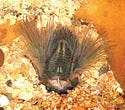October 1, 2009
R&D DIGEST
|
A synthetic glue that mimics the worm's could be applied to bone fractures. Photos courtesy of Alan Grant/University of California. Irvine |
The Sandcastle worm (Phragmatopoma californica) is a marine worm that glues broken bits of seashells and sand grains into a protective tubular shell. The worm does this with its own unique adhesive, which may hold some potential for medical applications, such as gluing bone fractures.
“What is unique about this adhesive is that it works underwater,” explains Russell Stewart, who presented a paper on the topic at a meeting of the American Chemical Society in August. “It's basically a water solution of proteins but yet it adheres under difficult circumstances.” Stewart is an associate professor in the department of bioengineering at the University of Utah. His team has created a synthetic version of the glue (a polyacrylate) that could have clinical applications.
Stewart says that in the worm's development of the substance, it solved several different problems that provided clues for developers of the polyacrylate. First, he says, the worm had to create glue that would wet the surface of submerged objects; i.e., it must displace the layer of water already on the submerged objects. Second, the glue had to stay together and not dissolve into the water. “We think it [solved the first two problems] by using proteins that are highly, but oppositely, charged. So some are negatively charged and some are positively charged. When they associate they form this semiimmiscible solution. It is water, but it is separated from water. It is also more dense than the water around it.”
The final challenge is that the adhesive had to turn from liquid to solid to have any shear strength. “The worm solves that problem by using the difference in the pH between the interior of the worm and sea water. When the adhesive is secreted, the pH changes dramatically from about 5 to 8.2, and that causes it to solidify.” The solidification occurs in about 30 seconds, and there is a second process that occurs over several hours. “This second process causes it to covalently cross-link so that it becomes like shoe leather,” says Stewart.
In creating the synthetic version of the worm's adhesive, Stewart's team copied the highly charged feature and was able to successfully reproduce the desired characteristics. “The charges are the most distinguishing features,” says Stewart. “So we wanted to copy that, but it wouldn't be practical to use proteins like the worm uses.”
|
The usual structures built by sandcastle worms depend on an adhesive that can be applied underwater. Mimicking the properties of the adhesive could lead to clinical applications. |
The team replicated the use of phosphates and amines, the same concentration of charges, and the same ratios as the worm adhesive. “When we mixed those synthetic polymers together, we got a phase-separated material that has the ability to wet submerged surfaces, he says. The synthetic also had the same setting functions—a quick set followed by stronger cross-linking after several hours.
Stewart says his next challenges are making the glue biocompatible and biodegradable. He says initial toxicity tests are promising, but there is still a long way to go. Eventually he hopes to commercialize the material as an effective medical adhesive. “We can use the condensed immiscible fluid as the delivery mechanism, so you can imagine applying it to a bone fracture. It would have that initial set process and then the material would continue to strengthen—there is nothing like this available today,” he says. Stewart says there is a strong need for such an adhesive in clinical settings. Funding is being provided by the National Institutes of Health.
Copyright ©2009 Medical Device & Diagnostic Industry
About the Author(s)
You May Also Like




